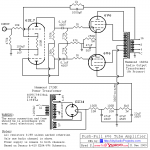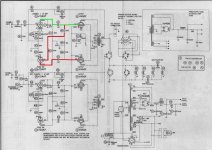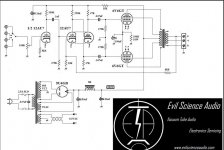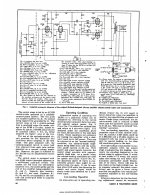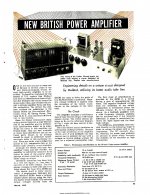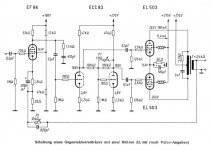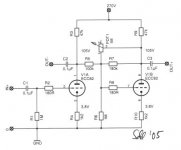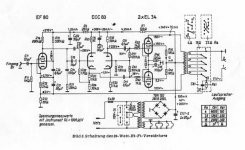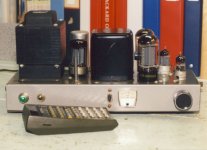I've recently completed a 6V6 pp amp, built into a Magnavox 175ff chassis, based on the Dynaco A-410 here. Since completing it, I've reconfigured the power supply to use the stock Magnavox choke (.75 H) and some more capacitance. This was after following suggestions to plug the original design into PSUD and finding it to have pretty poor smoothing. I'm now starting to realize the whole design is full of compromises and what originally attracted me (simplicity) is a weakness in terms of front end gain. Two options I'm looking at, since I want to maintain the power section and the chassis are the original Magnavox design or this from Evil Science. The Evil design seems to have fewer compromises. I'm also liking it because I can get the required B+ using diodes and there should be enough heater current for the extra 12AU7, since the original Magnavox was originally designed to power a separate preamp. I would guess the Evil design utilizes 8k outputs but it doesn't say specifically. So which would you pick? Thanks for the help, I'm very new to most of this and learning a lot as I go.
Attachments
"Call me crazy but I actually like the way that dynaco front end sounds."
Notice that the Dyna circuit returns the nfb to a low value resistor below the pentode cathode resistor.
This is better and more linear than returning it directly to the cathode.
The main fault of the Dyna driver circuit is the carbon comp resistors and the Black Cat capacitors,
especially the smallish screen capacitor.
Notice that the Dyna circuit returns the nfb to a low value resistor below the pentode cathode resistor.
This is better and more linear than returning it directly to the cathode.
The main fault of the Dyna driver circuit is the carbon comp resistors and the Black Cat capacitors,
especially the smallish screen capacitor.
Last edited:
Sadly, tho' I really do like the 'sound' of fairly simple valve amplifiers, I personally prefer JFET front ends. No microphonics, surprisingly close FET-to-FET matching (when bought all at once), and a deep noise floor. That, and being cheap-and-reliable enough to 'double up' after the front end gain stage, and use as impedance reducing source followers, also of pretty remarkable performance. Like a lot of valves, they have a 'soft' response characteristic.
Anyway, throw tomatoes.
This is a tube forum.
I should know better.
Heretic! Off with his soldering iron!
GoatGuy
Anyway, throw tomatoes.
This is a tube forum.
I should know better.
Heretic! Off with his soldering iron!
GoatGuy
Why Build Junk
When with the same tubes & other parts you could build a bullet proof classic, the Mullard 5-10. Built by thousands, many articles published including plenty of modifications to further improve performance.
Attached one of the original articles on this side of the pond describing the circuit in detail. And a bonus tone control front end.🙂
When with the same tubes & other parts you could build a bullet proof classic, the Mullard 5-10. Built by thousands, many articles published including plenty of modifications to further improve performance.
Attached one of the original articles on this side of the pond describing the circuit in detail. And a bonus tone control front end.🙂
Attachments
That's with EL84, here we talk about the 6V6 needing more then double input voltage.When with the same tubes & other parts you could build a bullet proof classic, the Mullard 5-10. Built by thousands, many articles published including plenty of modifications to further improve performance.
Attached one of the original articles on this side of the pond describing the circuit in detail. And a bonus tone control front end.🙂
And who needs a pentode front these days, to much gain and noise.
Mona
That's with EL84, here we talk about the 6V6 needing more then double input voltage. And who needs a pentode front these days, to much gain and noise.
Mona
All too true, but an amp designed for 6V6 or EL84 with proper biasing & OPT can be interchanged in almost anything. Don't think he has an EF86/Z729 anyway, a small triode will work well on the front end. With somewhat less gain.
If there is tube noise from a power amp, it is seldom from the front end. Better start looking somewhere else.
This is not rocket science at all. I don't subscribe to tube rolling, but this design challenge is not much more.🙂
Mona
All too true, but an amp designed for 6V6 or EL84 with proper biasing & OPT can be interchanged in almost anything. Don't think he has an EF86/Z729 anyway, a small triode will work well on the front end. With somewhat less gain.
If there is tube noise from a power amp, it is seldom from the front end. Better start looking somewhere else.
This is not rocket science at all. I don't subscribe to tube rolling, but this design challenge is not much more.🙂
The only difference with the moded evil then is cocertina versus long tail phase splitter.All too true, but an amp designed for 6V6 or EL84 with proper biasing & OPT can be interchanged in almost anything. Don't think he has an EF86/Z729 anyway, a small triode will work well on the front end. With somewhat less gain.
Mona
When with the same tubes & other parts you could build a bullet proof classic, the Mullard 5-10. Built by thousands, many articles published including plenty of modifications to further improve performance.
Attached one of the original articles on this side of the pond describing the circuit in detail. And a bonus tone control front end.🙂
Yeah, I think for my next amp I want to go with one of the "classic" topologies but for right now, I'm looking for a way to get a bit more gain and punch within a fairly specific set of parameters:
1) needs to work with the Magnavox 175 chassis and power supply, this means at most, one or two extra small (300ma heater or less) front end/phase tubes
2)needs to work with a 10w 8k output transformer wired in ultralinear
3)can't require more than a 350ish volt B+ at around 150ma (see pt limitations)
The three I posted all fall into this category (more or less). I'm glad to see some of you like the dynaco but to me it sounds a bit weaker than its 10-ish watts would suggest. All of my amps to this point have been 8-13 watt single ended units that deliver better bottom end and a more coherent overall presentation.
The Magnavox is a terrible choice for forum debate. Nobody wants to be seen with a Magnavox.
However for music at not wall-shaking volume it is a fine player. I'd just fix what's broke.
However for music at not wall-shaking volume it is a fine player. I'd just fix what's broke.
The Evil Science PP 6V6 Amp is very ordinary aside from the extra half 12AU7 on the front end. If the 2nd tube was a 12AX7 the extra tube would not be required.
Many of those using the EF86 pentode as a front end simply connected it as a triode to reduce gain not required. There is a minor adjustment of the NFB network required, usually OPT dependent. Don't think that something that worked for someone else will work every time. It probably won't.🙂
More phase inverters attached, somebody liked them.
Many of those using the EF86 pentode as a front end simply connected it as a triode to reduce gain not required. There is a minor adjustment of the NFB network required, usually OPT dependent. Don't think that something that worked for someone else will work every time. It probably won't.🙂
More phase inverters attached, somebody liked them.
Attachments
"The Evil Science PP 6V6 Amp is very ordinary aside from the extra half 12AU7 on the front end. If the 2nd tube was a 12AX7 the extra tube would not be required."
Dynaco did this in the ST35, (with EL84's and some positive feedback, but still) back when type 7247's still roamed the Earth, so this could be considered "classic". Mona's corrections are essential with random modern transformers, but the 7247's aren't.
YOS,
Chris
Dynaco did this in the ST35, (with EL84's and some positive feedback, but still) back when type 7247's still roamed the Earth, so this could be considered "classic". Mona's corrections are essential with random modern transformers, but the 7247's aren't.
YOS,
Chris
I built a PP 6L6GC guitar amp & used a 7247 front end. But that was circa 1965. The 7247 was a great idea. Are they still available at a reasonable price? I've not looked for a very long time. The 6AN8 seems to have taken over that application.
I used internal cathode to cathode NFB to get more gain from a 6SL7 driver much like the Evil circuit to drive PP 25L6s. It had a preamp of 6BH6 & a 12AX7.
The OPT was a Hammond 125D. It was used by a friend as a guitar practice amp. About 6 watts, but better than what he had. All built inside a Hammond 8x12x3 Chassis. Finished in Hammond speckled gray. That one around 1956.🙂
I used internal cathode to cathode NFB to get more gain from a 6SL7 driver much like the Evil circuit to drive PP 25L6s. It had a preamp of 6BH6 & a 12AX7.
The OPT was a Hammond 125D. It was used by a friend as a guitar practice amp. About 6 watts, but better than what he had. All built inside a Hammond 8x12x3 Chassis. Finished in Hammond speckled gray. That one around 1956.🙂
JJ (IIRC) built some 7247/12DW7's fairly recently, but I'm uncertain about current production. In a scratch-made stereo amp the 12AX7 and 12AU7 halves can be shared between channels for future-proofing. Perfectionists could even move up to 6SN7 or 5687 higher perveance valves for the splitter halves, with higher DC current for a little more Miller C driving ability, if there's enough filament power available.
YOS,
Chris
YOS,
Chris
Last edited:
You will have a hard time building a DC-coupled concertina with V+ of 300V driving the 6V6The Evil Science PP 6V6 Amp is very ordinary aside from the extra half 12AU7 on the front end. If the 2nd tube was a 12AX7 the extra tube would not be required.
There is a capacitor missing (both schematics) unless you like +110V on the grids 😀More phase inverters attached, somebody liked them.
Mona
There is a capacitor missing (both schematics) unless you like +110V on the grids 😀 Mona
You are absolutely correct. When I find these trick circuits I make a copy & set it aside for future reference. One of those examples has what looks like a date '05', noted by the author. Both appear to have been drawn by a professional. I guess the error simply slipped thru the system, no one noticed till it had gone out the door.😱
Attached another utilizing an anode follower from my file driving PP EL34s this time. It appears to be a production drawing.🙂
You are absolutely correct. When I find these trick circuits I make a copy & set it aside for future reference. One of those examples has what looks like a date '05', noted by the author. Both appear to have been drawn by a professional. I guess the error simply slipped thru the system, no one noticed till it had gone out the door.😱
Attached another utilizing an anode follower from my file driving PP EL34s this time. It appears to be a production drawing.🙂
Attachments
Last edited:
You will have a hard time building a DC-coupled concertina with V+ of 300V driving the 6V6.🙂 Mona
A good point, a problem many designers run up against. So AC coupling between those stages avoids that. Or use a pentode front end like a 6AN8, all in one bottle.
I went a further step driving PPUL 6L6GCs in a pair of amps built for my own use, the front end is a 6AU6 direct coupled to both sections paralleled of a 12AU7. That was circa 1962, they were in constant use till 1977 when I bought a Sansui AU717.🙂
A good point, a problem many designers run up against. So AC coupling between those stages avoids that. Or use a pentode front end like a 6AN8, all in one bottle.
I went a further step driving PPUL 6L6GCs in a pair of amps built for my own use, the front end is a 6AU6 direct coupled to both sections paralleled of a 12AU7. That was circa 1962, they were in constant use till 1977 when I bought a Sansui AU717.🙂
Attachments
Appreciate all the input, half i get, half i don't...........what is the general consensus on the initial question? I spent some time with the dynaco circuit last night; don't hate it but also, kinda eh on the sound.
Yeah, this forum seems to be much more about state-of-the-art circuits with complex SS enhancements. Basic amps pulled from old console stereos don't get much respect here. Every forum has its own personality, so to speak.The Magnavox is a terrible choice for forum debate. Nobody wants to be seen with a Magnavox.
However for music at not wall-shaking volume it is a fine player. I'd just fix what's broke.
There are numerous threads on the 175 / 185 on AK, where the humble Maggies get more respect.Appreciate all the input, half i get, half i don't...........what is the general consensus on the initial question? I spent some time with the dynaco circuit last night; don't hate it but also, kinda eh on the sound.
Although it's not a 175, you might find this thread about the Maggie 8800 PP 6V6 interesting. It includes info on how the mods can be applied to the 175 / 185 series.
Rx For the Magnavox 8800 Series | Audiokarma Home Audio Stereo Discussion Forums
I modded a 185 recently, using all stock transformers and 6N6G output tubes. It has a PT that's a bit larger than most 175 / 185s have, but it runs so cool that I suspect the more common, smaller, PT would also work. Front end uses 5751s and was copied from a well regarded Leben integrated which resembles the popular PP 6BQ5 Maggie and sells for $3500. Go figure. Here's a link:
Magnavox 175/185 Build . . . With a Twist | Audiokarma Home Audio Stereo Discussion Forums
Just curious, why do you need so much gain? What source are you using?
- Home
- Amplifiers
- Tubes / Valves
- Too simple? Need some redesign advice
